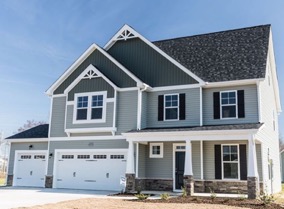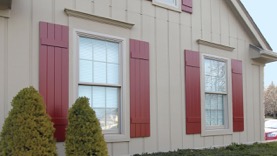Shutters were originally used to protect homes from harsh elements or provide shade. Today, they are more commonly installed as an accent, to add color to exteriors and increase curb appeal. This shift from functional to decorative use has diminished the authenticity of many home designs, leaving many to wonder: Which shutters capture the authentic look of popular home styles?
Here are a few guidelines to consider:
Craftsman
The appeal of Craftsman-style homes is that they can be customized to create truly one-of-a-kind designs. These homes take pride in their high quality and craftsmanship, but also have a humble simplicity with clean lines and timeless architectural details. Craftsman-style homes have experienced a resurgence because of their versatility and emphasis on quality.

Although Shaker shutters are one of the most frequently used styles for Craftsman homes, this type of home works with virtually any shutter style. Board-and-batten shutter designs are popular for exteriors that have more rustic details, while flat and raised panel options offer a clean look similar to the Shaker style.
Urban Farmhouse
With its down-to-earth comfort, the Farmhouse style is regaining popularity among homeowners who seek the charm of country style with modern touches. These homes often feature wraparound porches, vertical siding similar to barn house siding, and minimalist design features. Shutters add an interesting architectural detail on an otherwise simple exterior.

Board-and-batten shutters capture an authentic Farmhouse style and create an inviting country exterior. They have a range of style options, including spaced or joined boards, and two or three cross battens. For a less rustic take on the Farmhouse style, louvered shutters are another popular option due to their versatile, traditional design.
Colonial
A true American classic, Colonial homes reflect the earliest home styles of the first European settlers. These homes feature square, symmetrical designs with refined, formal details like dentil moulding.

Traditional Colonial shutter styles vary across regions due to differences in climate. Colonial homes in the north are often equipped with paneled shutters, which were originally used as a defense against harsh elements like wind and snow in the New England region.
Southern Colonial homes, on the other hand, typically feature louvered shutters. The angled slats of louver shutters helped keep the interior of the home cool by blocking sunlight while allowing airflow. Many Southern regions, such as Charleston, S.C., honor the traditional design and feature classic louvered shutters, both in paneled louvered and full-length styles.
Cape Cod
Inspired by New England Colonial style designs, Cape Cod homes feature clean, symmetrical designs and dormers. However, these home styles are less formal and have cozier, more cottage-like floor plans and exteriors.

Homeowners can achieve an authentic Cape Cod design with any shutter style. These homes often feature raised panel, louvered, and board-and-batten shutters. Still, many homeowners are shifting toward paneled shutters because they do not collect dirt as easily as other styles and are less susceptible to nuisances like insect nests.
Atlantic and Mid-America shutters are designed with authenticity in mind, with architecturally accurate designs and more depth and dimension. View the full line of Mid-America shutters and Atlantic shutters to capture the right look.
5 Best Practices for Going Bold With Exterior ColorWhen used well, bold colors can add a tasteful pop of life to a home’s exterior. When used poorly, you can end up attracting negative attention.
Here are five tips from Trisha Wagner, senior product manager and an authority on color at Boral Building Products, to ensure your use of bold is gorgeous, not gaudy.
1. The best place for bold color is in a home’s decorative details
While it always depends on the house, bold colors are generally best used in a home’s accents, such as the shutters and front door. It’s one of the fastest ways to have a large impact and can completely transform a home’s look and feel. Even better, these details are often the easiest—and most affordable—to change later with either a fresh coat of paint or replacement.

2. Remember to coordinate
One of the first things to consider when picking bold accents is the home’s siding color. You want to select accent colors, such as on the trim, shutters, and front door, that work well with the siding, so consult the color wheel for reference. As explained on Color Matters, “color harmony” can be achieved by choosing analogous colors (three colors side by side on the wheel) or complementary colors (directly opposite each other on the wheel). This can be especially helpful in moving beyond traditional colors. For example, instead of the typical pale yellow, try a deep maize yellow paired with red, coral, or cobalt accents.
3. Pay attention to the entire home exterior
The front of the home isn’t the only area people see. Don’t forget to decorate the back and sides of a house, particularly since outdoor living is more important to buyers than ever before. A bare side or rear home exterior looks and feels unfinished; shutters and accents on these walls will add dimension and complete the look.
4. Find what works for you
If clients are uncertain about incorporating bolder colors, encourage them to experiment with different tones before making their final selection. If a home’s style doesn’t support shutters, consider using just a bold trim color. You can also soften a home’s look by pairing white or cream trim with one or two bold accents. For a less-permanent option, incorporate bold colors into the landscape design, such as bright-red or -purple flowers and plants, a jewel-toned bird bath, or even a painted fence.
 White can be a bold choice against a neutral cladding.
White can be a bold choice against a neutral cladding.
5. Don’t discount the power of white
In the sea of tans and beiges that dominate today’s exteriors, white becomes a stark contrast that is a bold choice in and of itself. A crisp white trim against a richer-toned cladding is eye-catching and stands out from homes with cream accents.
For more design inspiration, visit www.kleerlumber.com and www.truexterior.com.